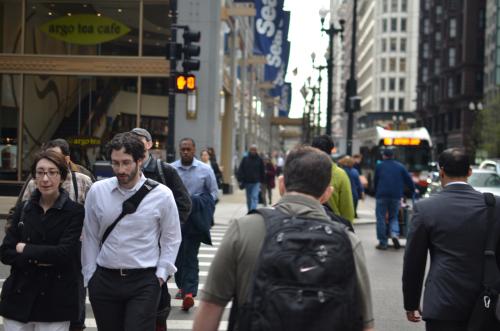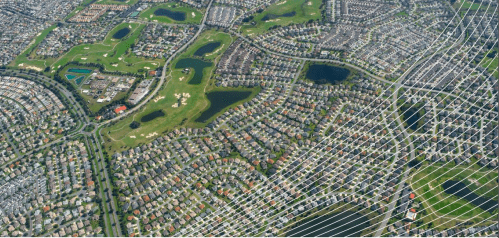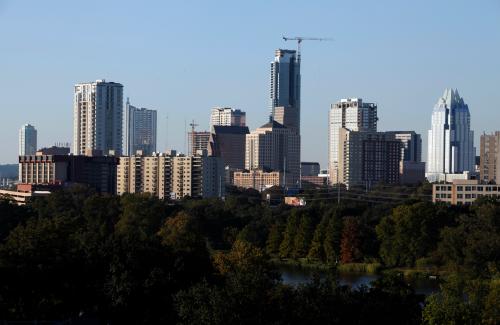Research has historically framed income inequality as a national issue, one best addressed through national monetary and fiscal policies that raise demand for labor and redistribute resources from the rich to the poor. Yet widening disparities across and within places in the United States, revealed in debates around wages, housing affordability, and public safety, have motivated policymakers and researchers to pay increased attention to inequality’s local dimensions.
Now, many cities’ aggressive bids for Amazon’s second headquarters are heightening anxieties that the company’s expansion could further accelerate inequality wherever it eventually lands (as many say it has in Seattle). The debate about Amazon fits into a wider set of concerns about the tech sector’s role in contributing to income inequality, via the winner-take-all dynamics of the digital economy.
Amid these currents, this piece updates previous Brookings Metro analyses to examine trends in household income inequality in the 100 largest U.S. metropolitan areas and their most populous central cities from 2014 to 2016. As with earlier analyses, it uses data from the U.S. Census Bureau’s American Community Survey on household income at the 95th percentile of the distribution (i.e., where only 5 percent of households earn more) and the 20th percentile of the distribution (i.e., where 20 percent of households earn less).1 It uses the ratio between those incomes as a principal measure of inequality in cities and metro areas. Key findings include:
Among big cities, Atlanta and Washington, D.C. exhibited the highest rates of income inequality in 2016. The top 5 percent of households in these cities earned incomes at least 18 times as high as the bottom 20 percent of households. Relatively wealthy cities including Boston, New York, and San Francisco, as well as cities struggling with high poverty such as Buffalo, Miami, New Orleans, and Providence, also registered high rates of income disparity. In general, older cities with fewer middle-class neighborhoods and larger amounts of subsidized housing tended to exhibit higher inequality. Newer, more geographically expansive cities such as Columbus, Jacksonville, and Virginia Beach, as well as those with stronger middle-class employment like Allentown and Oxnard, had among the lowest levels of income inequality.
 Levels of inequality in cities reflect broader income disparities in metropolitan areas. Four of the 10 cities with the highest levels of inequality are located in one of the 10 most unequal metropolitan areas (Boston, New Orleans, New York, San Francisco). Conversely, three of the cities with the lowest levels of inequality are located in one of the 10 most equal metropolitan areas (Des Moines, Lakeland, Virginia Beach). This indicates that city inequality reflects not only local housing dynamics but also wider industrial and income patterns in the regional labor market. Notably, three regions along Utah’s Wasatch Front—Salt Lake City, Provo, and Ogden—exhibit the lowest levels of income inequality among their metropolitan peers.
Levels of inequality in cities reflect broader income disparities in metropolitan areas. Four of the 10 cities with the highest levels of inequality are located in one of the 10 most unequal metropolitan areas (Boston, New Orleans, New York, San Francisco). Conversely, three of the cities with the lowest levels of inequality are located in one of the 10 most equal metropolitan areas (Des Moines, Lakeland, Virginia Beach). This indicates that city inequality reflects not only local housing dynamics but also wider industrial and income patterns in the regional labor market. Notably, three regions along Utah’s Wasatch Front—Salt Lake City, Provo, and Ogden—exhibit the lowest levels of income inequality among their metropolitan peers.
More cities experienced declines in income inequality from 2014 to 2016 than saw increases. While few cities overall saw income disparities between rich and poor households change by a statistically significant margin, among those that did, declines in income inequality (eight) outnumbered increases (five). From 2014 to 2016, high-income households in 30 cities logged significant income gains, as did low-income households in 34 cities. (In only one city—Rochester—did low-income households suffer a statistically significant income decline.) The net effect reduced income disparities in Charlotte, Dallas, Jackson, Jacksonville, Kansas City, Knoxville, Louisville, and Salt Lake City, but pushed them higher in Baltimore, Detroit, Omaha, Rochester, and Washington, D.C.
 In contrast to the city pattern, increases in metropolitan income inequality outnumbered declines. From 2014 to 2016, 12 metropolitan areas registered a statistically significant increase in income inequality. In most of those places, high-income households enjoyed income gains while low-income households did not. In Honolulu and San Jose, top incomes rose by an estimated $60,000 in two years’ time, but did not change significantly for low earners. Only eight metro areas achieved declines in income inequality, with lower-income households posting larger income gains (in percentage terms) than higher-income households in most of those markets. Metro areas where income disparities narrowed included many of the cities—Charlotte, Dallas, Kansas City, Knoxville, and Louisville—where income inequality declined, as well as Boston, New Haven, and Salt Lake City.
In contrast to the city pattern, increases in metropolitan income inequality outnumbered declines. From 2014 to 2016, 12 metropolitan areas registered a statistically significant increase in income inequality. In most of those places, high-income households enjoyed income gains while low-income households did not. In Honolulu and San Jose, top incomes rose by an estimated $60,000 in two years’ time, but did not change significantly for low earners. Only eight metro areas achieved declines in income inequality, with lower-income households posting larger income gains (in percentage terms) than higher-income households in most of those markets. Metro areas where income disparities narrowed included many of the cities—Charlotte, Dallas, Kansas City, Knoxville, and Louisville—where income inequality declined, as well as Boston, New Haven, and Salt Lake City.
 Some cities posted stunning increases in top incomes from 2014 to 2016. The most astonishing changes in the mid-2010s occurred among high-income households in a few cities characterized by booming technology economies. In just two years, incomes for 95th percentile households in San Francisco rose nearly $120,000. (Median home sales prices, meanwhile, increased by $250,000.) Austin and Seattle posted increases of nearly $65,000 for high-income households, while high household incomes in San Jose rose by more than $50,000. Raleigh topped all cities for 20th percentile income growth at $7,200, which was large in percentage terms (30 percent) but a far cry in absolute terms from the $35,000 increase the city posted at the 95th percentile level.
Some cities posted stunning increases in top incomes from 2014 to 2016. The most astonishing changes in the mid-2010s occurred among high-income households in a few cities characterized by booming technology economies. In just two years, incomes for 95th percentile households in San Francisco rose nearly $120,000. (Median home sales prices, meanwhile, increased by $250,000.) Austin and Seattle posted increases of nearly $65,000 for high-income households, while high household incomes in San Jose rose by more than $50,000. Raleigh topped all cities for 20th percentile income growth at $7,200, which was large in percentage terms (30 percent) but a far cry in absolute terms from the $35,000 increase the city posted at the 95th percentile level.
Income trends at the top of the distribution in cities and metro areas had little relationship to trends at the bottom of the distribution from 2014 to 2016. In cities and metro areas where high-income households posted the greatest gains, low-income households didn’t fare any better or worse than those in other cities. For instance, although 20th percentile incomes in Austin, San Francisco, and Seattle rose by significant margins, they failed to increase significantly in other cities where 95th percentile incomes boomed, such as Baltimore, Denver, San Jose, and Washington, D.C. At the same time, incomes at the lower end of the distribution grew significantly in several cities—Boston, Charlotte, Louisville, Salt Lake City—where top incomes did not.
For those concerned about the effects of high inequality in the United States generally, and in our large urban centers specifically, these city and metropolitan income trends from 2014 to 2016 present some quandaries.
On the one hand, the trends indicate that ameliorating inequality is possible. In several places, low-income households achieved faster income gains than high-income households.
On the other hand, even as a tighter labor market began to drive up wages in the mid-2010s, the relative gap between the rich and poor still widened in a number of cities and metro areas. And even in places where low- and high-income households made comparable progress in percentage terms, the absolute income difference between rich and poor often grew substantially. The inequality ratio did not change in San Francisco, but the distance between its 20th and 95th percentile incomes grew by an estimated $114,000.
Moreover, at least in the short run, city and metropolitan income trends do not suggest the existence of a rising tide lifting all boats, but rather separate ebbs and flows for households at different extremes of the distribution. Even if, as Enrico Moretti and other researchers suggest, local innovation economies generate greater opportunities for workers in less-skilled industries, those opportunities may not materialize overnight, and low-income workers and families could get priced out of a city in the meantime.
While this analysis is too brief to identify the underlying economic or policy factors that may explain those disparities, Brookings Metro’s forthcoming Metro Monitor update will shed further light on how and why economic inclusion is changing in metropolitan areas. Regardless, the distinctively local dynamics of inequality in our major urban areas reaffirm the importance of local leadership for understanding and improving access to economic opportunity for lower-income households in ways that reduce disparities over the longer term.
Cecile Murray provided valuable research assistance for this analysis.
-
Footnotes
- In cities and metropolitan areas where 95th percentile household income was top-coded at $250,000+ in summary file data, Brookings used ACS microdata to estimate both 20th and 95th percentile incomes and associated margins of error.






